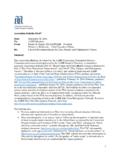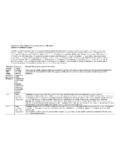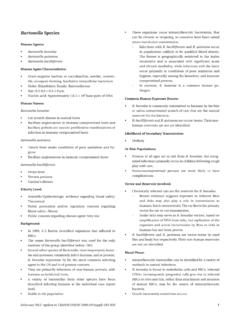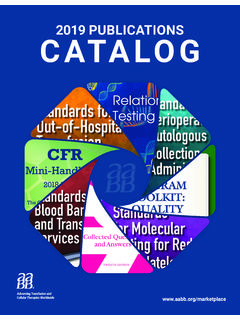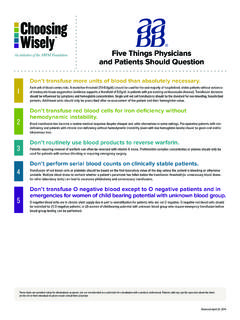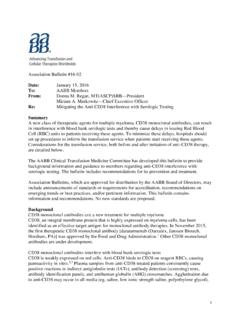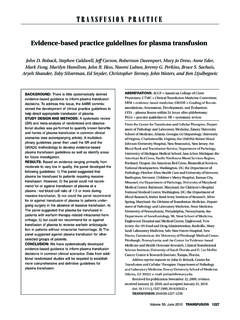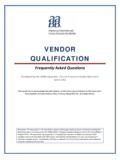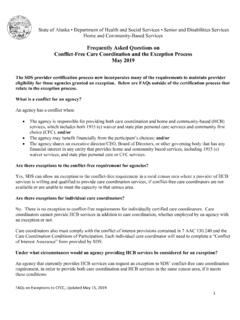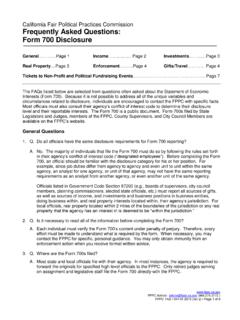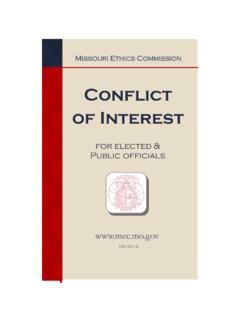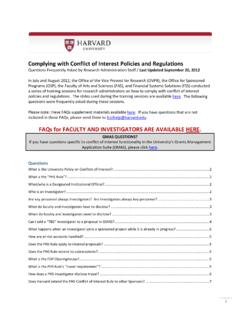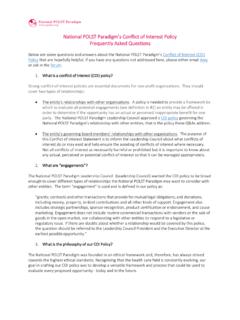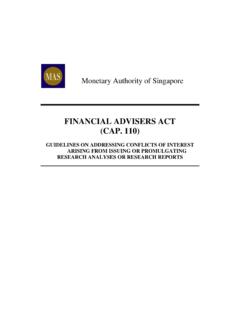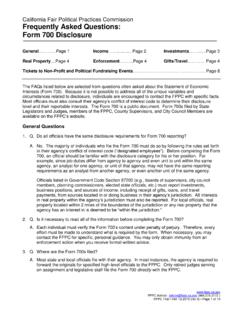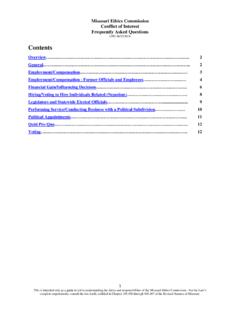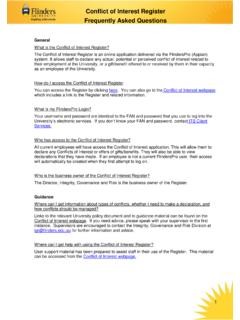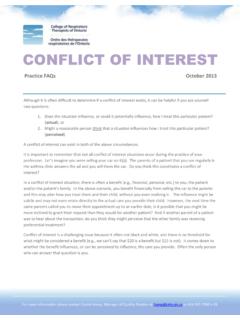Transcription of Conflicts of Interest and Confidentiality FAQs - AABB
1 1 Conflicts of Interest and Confidentiality faqs October 1, 2016, Updated August 7, 2017 General 1) Why has AABB updated its Conflicts of Interest policy? AABB has updated its Conflicts of Interest and Confidentiality Policy as part of its ongoing efforts to protect AABB s reputation for accurate and unbiased work that optimizes patient and donor care and safety. The revised policy reflects the core values that have guided AABB since its inception the pursuit of excellence, focus on the patient and donor, integrity, transparency, consensus building and innovation. AABB continues to integrate these core values into daily activities, helping to ensure that AABB s decision-making processes are beyond reproach. 2) What are the major differences between the current and updated policies?
2 A. The updated policy applies to all AABB programs, including the Transfusion journal editorial board including the Editor-in-Chief, associate editors and contributing authors. Previously, the Transfusion journal had a separate COIP. b. The definition of Financial Interest has been broadened. The threshold for reporting direct financial holdings was decreased from $15, to $5, and now includes companies with activities related to AABB s. Also included, if received within the past two years, are -- a) Payments from any one source valued at more than $5, for any combination of paid consultancies, speaker fees, honoraria, expert testimony, research funding or royalties; b) Any gifts valued at more than $ c. A definition of Professional Interest was added.
3 D. The policy was clarified: Those with a disclosed conflict may not vote on an issue giving rise to the conflict. 3) Who is included in the scope of this policy? This policy applies to the following categories of individuals: 1. AABB individual members who serve on the board and committee members, including representatives from other organizations who serve on AABB committees, members of interorganizational task forces for which AABB serves as the lead organization and AABB work groups; 2. Volunteer assessors; 3. Permanent and Temporary Employees; 4. Editorial Board, including the Editor-in-Chief and Associate Editors (collectively referred to as Editorial Board ) and the contributing authors ( Authors ) of the Transfusion journal.
4 4) When do affected individuals have to make these disclosures? 2 The policy took effect with the 2016-17 committee assignments. Individuals appointed to committees will receive electronic disclosure forms from the Executive Office in September before each new association year. The disclosure forms must be received prior to beginning work on the committee. The disclosures must be made annually and updated prior to every meeting or call as relevant Conflicts arise. 5) What kinds of interests must be disclosed? Financial, professional and/or personal interests either your own or those of your spouse, domestic partner or minor children that might directly interfere with any judgments you might make on behalf of AABB, or even those that give the appearance of influencing your ability to act in the best interests of the organization, must be disclosed.
5 Financial interests include any direct financial holdings with the exception of mutual funds valued at $5,000 or more in any medical or biomedical company, including companies with activities addressed in any of AABB s standards, such as medical device companies or information technology companies that produce medical software and/or are related to any of AABB s activities. For example, if Jane Doe owns stock in Medical Company X valued at $16,000, and she is making a decision on behalf of AABB that might have an effect, negative or positive, on that company s business, she would need to disclose the fact that she owns stock in Medical Company X. She would not, however, need to disclose the actual number of shares or value of the stock owned.
6 A professional Interest that might need to be disclosed is membership on another entity s board of directors or advisory committee. For example, if an AABB committee member is also on the board of another organization involved in issues related to blood and tissue donor and patient safety, that board membership should be disclosed because the committee member may feel that he or she must balance competing interests of both organizations. On the other hand, an AABB committee member who is on the board of his or her child s private school need not disclose that relationship because participation is unlikely to affect that person s judgment or impartiality with regard to AABB activities. A personal Interest that might need to be disclosed is a close friendship between an AABB committee member and the CEO of a company involved in blood banking whose business might be affected by a committee decision.
7 Consider a friendship that is longstanding, involves weekly golf games at the CEO s golf club and the use of the CEO s oceanfront summer home for two weeks every summer. Even if this relationship would not actually affect the committee member s judgment or impartiality with regard to AABB activities, it would certainly rise to the level of an apparent conflict of Interest . On the other hand, an occasional golf game with an executive of a company involved in blood banking whose business might be affected by the committee decision probably would not rise to the level of a personal relationship requiring disclosure. A key consideration in determining whether professional and personal relationships require disclosure is whether the situation is likely to interfere or appear to interfere 3 with the independent judgment needed to make decisions on behalf of AABB.
8 A good test is whether relevant others (your employer, your clients, professional colleagues or the general public) would trust your judgment if they knew of this personal or professional relationship and you were in a position to influence decisions on behalf of AABB. 6) How will the updated policy affect the way in which committee meetings are run? The committee chair, with the assistance of the staff liaison, will be responsible for following six steps prior to and during all committee meetings, including conference calls, in order to make sure the policy is fully implemented. First, the committee chair will review the Conflicts of Interest which will be sent by the staff liaison before each meeting to identify whether any Conflicts are anticipated.
9 Second, staff liaisons will email all committee members prior to the meeting or call requesting disclosure of any new actual or apparent Conflicts . Third, at the beginning of every committee meeting, the chair will read the provided COI script and obtain acknowledgment from all present that they understand the policy and agree to abide by it. The chair also will ask whether anyone present has any new actual or apparent Conflicts to disclose for purposes of the meeting. Those with new Conflicts to disclose will be asked to complete the electronic form ASAP. Fourth, during committee discussions, those with Conflicts relating to specific issues will be expected to make known the fact that they have a conflict. The chair is then responsible for determining whether the conflicted individuals may participate in the discussion.
10 If the chair is aware of a conflict and a conflicted individual doesn't make the conflict known, the chair should raise the issue and may ask that individual to abstain from the discussion. Fifth, before any vote is taken, the chair will identify anyone who has a conflict relating to the issue at hand. According to the policy, committee members with Conflicts relating to an issue will not be permitted to vote on that issue. The staff liaison will record all votes and abstentions by name ( , the vote passed 7 to 5; Jane Smith abstained from discussion and Jane Smith and Joe Jones abstained from voting). Sixth, at the close of the meeting, the chair will review which items are confidential and may not be disclosed. The chair also will remind representatives that reports from committee or task force representatives to their organizations need to be made in writing and approved by the chair before dissemination.

